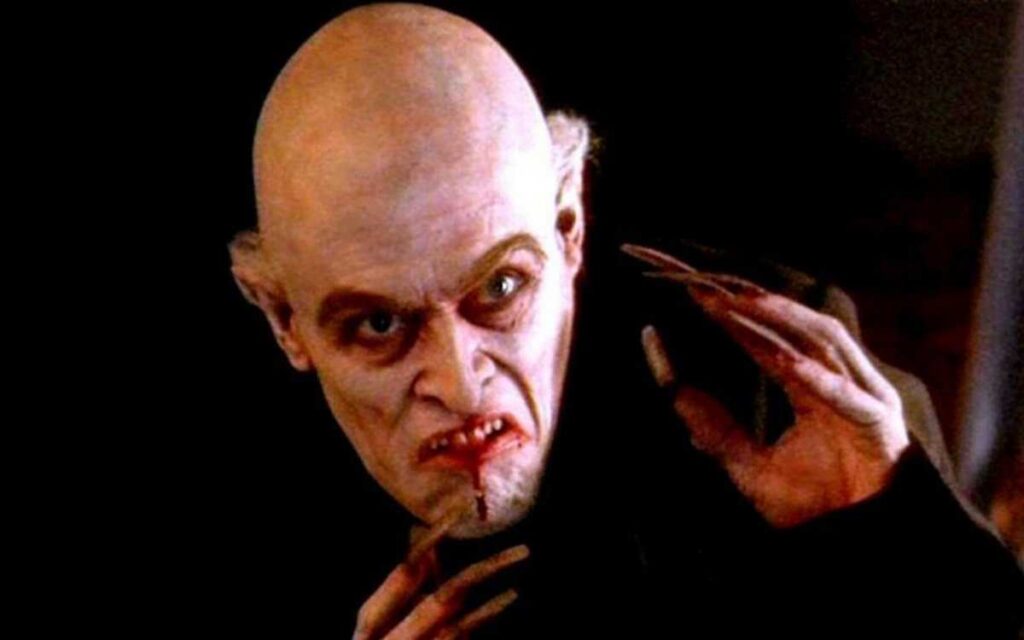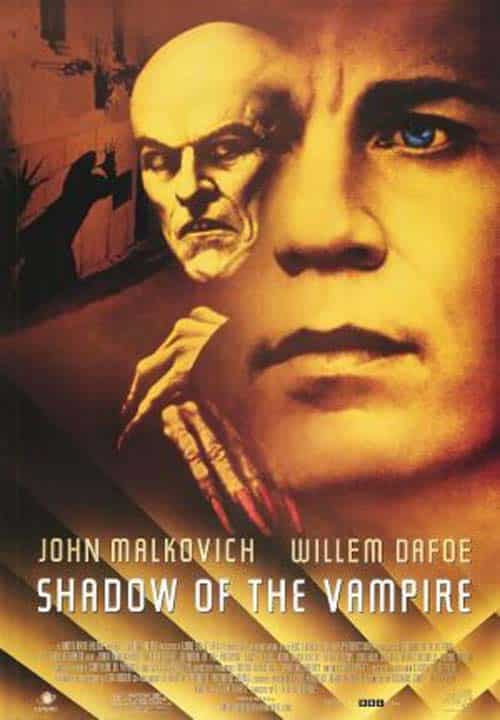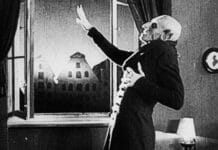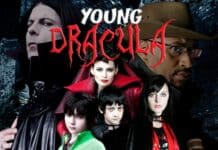RICHARD MARKWORTH takes a look at Shadow of the Vampire 2000, a fictional take on the making of F.W. Murnau’s Nosteratu

TITLE: Shadow of the Vampire
YEAR RELEASED: 2000
DIRECTOR: E. Elias Merhige
CAST: John Malkovich, William Dafoe, Udo Kier, Cary Elwes, Catherine McCormack, Eddie Izzard
In 1922 German Expressionist director, F W Murnau, shot an unlicensed silent adaptation of Bram Stoker’s novel, Dracula, re-naming the central character Count Graf Orlok in an apparent move to side-step any pesky copyright payments.
Although Stoker’s widow successfully sued for breach of copyright, and the court ordered all prints be destroyed, the film survived. Thankfully so, because Nosferatu: A Symphony of Horrors has widely become accepted as a true classic of the horror genre.
The most striking change Murnau made for his adaptation was dramatically transforming the appearance of Stoker’s vampire into something barely human. Feral and rat-like with a bald pate, pointed ears and long, talon-like nails, this Count, far removed from the novel’s moustachioed nobleman, is the un-living stuff of nightmares made flesh.
This image has endured in popular culture for nearly a century and been referenced in many later productions, such as Tobe Hooper’s TV miniseries adaptation of Stephen King’s novel Salem’s Lot (1979).
Orlok was portrayed by an actor little known outside Germany, Max Schreck, whose surname was aptly the German word for “fright”. This apparent nom de plume has added to the mystery of the character down the years and helped form Orlok/Schreck into an almost real-life bogeyman in the public consciousness.
In Shadow of the Vampire (2000), director E Elias Merhige weaves a tale based on the premise that Murnau, played by John Malkovich, strikes an unholy bargain with Schreck (Willem Dafoe), who is in fact a genuine vampire, to appear in his film. All Schreck must do is act as directed until his final scene when he will be rewarded with leading lady Greta Schroeder (Catherine McCormack) to feed upon. However, Schreck’s vampiric nature proves too domineering for the obsessed Murnau to control, and a power struggle develops between the two as the crew begins to dwindle.

Schreck is presented to the cast and crew of Nosferatu as a member of a renowned theatre company who, they are told, will only ever appear at night and in character. His introduction to the audience is cleverly built up, initially glimpsed in a part-reveal when an unseen party provides him with a live, caged ferret. Once he is fully revealed to both the viewer and the onscreen crew his presence provokes a growing feeling of disquiet made tangible by Merhige’s expert direction.
Shadow of the Vampire – a tale of two monsters
In what effectively becomes a story of two monsters, Malkovich is outstanding as the driven Murnau, fanatically pursuing his artistic goal at all costs despite his increasingly ineffective protestations that his people must remain unharmed. His statement to leading lady Greta that “It is the role that will make you great as an actress. Consider it a sacrifice for your art” is superbly sinister in context and packs a tremendous punch once she realises the true implications of Murnau’s words.
Dafoe, Oscar-nominated for his performance, is masterful as Schreck. His wonderfully repulsive make-up transforms him into the embodiment of the famous monster, and he brings a truly unsettling portrayal of the undead predator to the screen. This is particularly evidenced in a disturbing sequence in which the hungry vampire stalks the crew, trying the door handles of their rooms in search of a victim.
Conversely, in a scene where Schreck joins a drunken conversation between producer Albin Grau (an understated Udo Kier) and screenwriter Henrik Galeen (John Aden Gillet), Dafoe manages to successfully evoke a level of sympathy for the fiend, despite snacking on a passing bat, as he discusses the inherent sadness at the core of the literary character of Dracula. Grau and Galeen still believing the vampire to be a genius immersed in character, simply consider this further evidence of Schreck’s phenomenal method acting.
Merhige cleverly employs established horror tropes and imagery. For instance, Murnau, referred to as “Herr Doktor” throughout, and his crew, bedecked in white coats and goggles, give the impression of classic mad scientists at work. When on-location filming of Nosferatu is interrupted by the landlady of the inn where the crew are staying, unhappy at the removal of crucifixes from her premises, the filmmaker’s arrival into a “true-life” vampire story, including the requisite superstitious peasant, is complete.
The film is eerily lit, imbuing proceedings with a creeping feeling of unease as Schreck’s true nature becomes apparent and the whole cast, including Eddie Izzard and Carey Elwes, are exceptional.
Shadow of the Vampire succeeds as both a straight horror film and as a cautionary study of the all-consuming nature of the creative process and the extreme lengths to which an artist who treads the fine line between insanity and genius, may go to realise their vision.
Tell us your thoughts about Shadow of the Vampire 2000 in the comments section below!
Watch Shadow of The Vampire 2000 Trailer
RICHARD MARKWORTH and Ian J Walls have co-written a new comedy-horror book called Igor and the Twisted Tales of Castlemaine, available from Amazon or the Troubadour website. It follows eponymous lab assistant, Igor, after he leaves Victor Frankenstein and finds himself embroiled in a series of misadventures featuring both classic and all new monsters.









